-
New Directors/New Films and Film Comment Selects 2012
NEW DIRECTORS/NEW FILMS and FILM COMMENT SELECTS 2012
__________________________________________________ _________________________
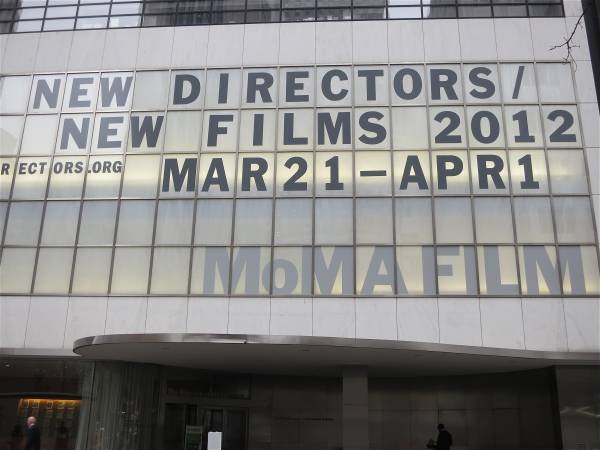
MoMA'S FILM ENTRANCE ADVERTISES NEW DIRECTORS 2012
Film CommentSelects and NewDirectors/NewFilms are two separate series put on by the Film Society of Lincoln Center, FCS a series chosen by staff members of the Film Society of Lincoln Center's in-house monthly, New Directors in collaboration with the Museum of Modern Art. I will cover the press & industry screenings of New Directors/New Films, which generally include all the selections. Of Film Comment Selects I will see only a few. That series is spread out and this year did not have a program of press screenings.
Links to the reviews:
5 Broken Cameras (Emad Burat, Guy Davidi 2011)--ND/NF
Ambassador, The (Mads Brügger 2011)--ND/NF
Breathing (Karl Markovics 2011)--ND/NF
Crulic: The Path to Beyond (Anca Damian 2011)--ND/NF
Donoma (Djinn Carrénard 2011)--ND/NF
Faust (Aleksandr Sokurov 2011)--FCS
Found Memories (Júlia Murat 2011)--ND/NF
Generation P (Vincent Ginzburg 2011)--ND/NF
Gimme the Loot (Adam Leon 2012)--ND/NF
Goodbye (Mohammad Rasoulof 2011)--ND/NF
Hemel (Sacha Polak 2012)--ND/NF
How to Survive a Plague (David France 2012)--ND/NF
Huan Huan (Song Chuan 2011)--ND/NF
I Wish (Hirakazu Koreeda 2011)--FCS
It Looks Pretty from a Distance (Anka, Wilhelm Sasnal 2011)--ND/NF
Las Acacias (Pablo Giorgelli 2011)--ND/NF
Minister, The (Pierre Schöller 2011)--ND/NF
Oslo, August 31st (Joachim Trier 2011)--ND/NF
My Own Private River (James Franco 2012)--FCS
Neighboring Sounds (Kleber Mendoça Filho 2011)--ND/NF
Now, Forager (Jason Cortland, Julia Halperin 2012)--ND/NF
Omar Killed Me (Roschdy Zem 2011)--ND/NF
Oversimplification of Her Beauty, An (Terence Nance 2012)--ND/NF
Porfirio (Alejandro Landes 2011)--ND/NF
Rabbi's Cat, The (Joann Sfar, Antoine Delesvauz 2011)--ND/NF
Raid, The: Redemption (Gareth Evans 2012)--ND/NF
Rebellion (Mathieu Kassovitz 2011)--FCS
Romance Joe (Lee Kwang-kui 2011)--ND/NF
Teddy Bear (Mads Metthieson 2011)--ND/NF
Twilight Portrait (Angelina Nikonova 2011)--ND/NF
Where Do We Go Now (Nadine Labaki 2011)--ND/NF
Click on the title below for the YouTube video (4 mins.).
Ken Burns on New Directors/New Films
"It was like a union card that says, 'Yes you can.' And yes, we all did."
"That afternoon at New Directors cemented what it meant to be a filmmaker for me."
Filmleaf General Forums thread for ND/NF and FCS 2012 here.
Last edited by Chris Knipp; 02-06-2016 at 09:53 AM.
-
film comment selects

The full program is below. I plan to review Sokurov's Faust, James Franco's My Own Private River, Hirakazu Koreeda's I Wish and Mathieu Kassovitz's Rebellion. I have already reviewed Joshua Marston's The Forgieness of Blood, Kenneth Lonergan's Margaret, and Nanni Moretti's We Have a Pope.
A Stoker
Alexei Balabanov, 2010
Sat Feb 25: 5:30 pm
An elderly, not-all-there Afghan war veteran known as “the major” feeds the murder victims of cops and mobsters into an apartment building furnace while working on an epic historical novel in the latest nihilistic crime drama from Russian provocateur Alexei Balabanov (Cargo 200).
All Watched Over By Machines of Loving Grace
Adam Curtis, 2011
The BBC essay filmmaker behind 2007’s The Power of Nightmares is back with a new three-part work on mankind’s dependency on computer technology. Compulsive viewing.
Almayer’s Folly
Chantal Akerman, 2011
Sun Feb 26: 1:00 pm
Chantal Akerman updates the first novel by Joseph Conrad from the late 1890s to the 1950s, and uses it as a springboard for an examination of the bankruptcy of colonialism through the struggle between a European father and Malaysian mother for possession of their daughter.
Alps
Yorgos Lanthimos, 2011
Thu Mar 1: 9:30 pm
In the latest warped and absurdly funny exploration of unnatural doings from the director of Dogtooth, a secret society consisting of four members offers a unique service: the recently bereaved can hire them for a few hours a week to act as surrogates for deceased loved ones, in order to help them adjust to their loss.
Altered States
Ken Russell, 1980
Fri Feb 24: 9:30 pm
Fearless scientist William Hurt plumbs the unborn soul of mankind through psychedelic freak-outs in a sensory-deprivation tank. In memory of Ken Russell, who died in November.
Despair
Rainer Werner Fassbinder, 1978
Thu Feb 23: 1:30 pm | Wed Feb 29: 4:30 pm
Based on a novel by Nabokov, scripted by Tom Stoppard, and starring Dirk Bogarde, Fassbinder’s first English-language film, a black comedy about a chocolate manufacturer plotting the perfect murder, is a must-see for all, not just Fassbinder completists.
Face to Face
Ingmar Bergman, 1975
Wed Feb 22: 3:30 pm | Fri Feb 24: 1:30 pm
Liv Ullmann is front and center in this underseen Bergman film, playing a disturbed psychiatrist who has an affair with a fellow doctor (Erland Josephson), only to succumb to a nervous breakdown seemingly triggered by haunting memories from her past.
Faust
Aleksandr Sokurov, 2011
Tue Feb 21: 3:15 pm | Tue Feb 28: 9:00 pm
Winner of the Venice Film Festival’s Golden Lion, Russian master Aleksandr Sokurov’s idiosyncratic and playful reinvention of Goethe’s play positions Faust’s craving of knowledge and power (i.e., the Enlightenment) as the source of 20th-century evil.
Headhunters
Morten Tyldum, 2011
Thu Feb 23: 6:30 pm | Fri Feb 24: 4:15 pm
A slick, charming corporate recruitment specialist leads a double life as an art thief in this twisty and fast-paced thriller that heralds the arrival of an exciting new directorial talent—and will keep you guessing all the way to its finale.
I Wish
Hirokazu Kore-eda, 2011
Wed Feb 22: 1:00 pm
Japan’s answer to Truffaut, Hirokazu Kore-eda, returns with a truly sweet, low-key film about two brothers trying to reunite their parents. Starring comedy duo Koki and Ohshiro Maeda.
Land Passion War of the Dead Christ Worlds
Special Event! J. Hoberman in person!
Based on 25 years of stunt projections and class presentations at NYU and Cooper Union, it’s Doomsday USA, starring Asia Argento, Tom Cruise, Dakota Fanning, Dennis Hopper, and the mind of Mel “Mad Max” Gibson. With subtitles!
Le sauvage
Jean-Paul Rappeneau, 1975
Tue Feb 21: 9:00 pm
The Film Society’s 2012 Gala honoree Catherine Deneuve and Yves Montand co-star in this unlikely, lightning-paced screwball farce set in Venezuela, restored and presented in the 2011 Cannes Film Festival’s “Classics” section.
Life Is Sweet
Mike Leigh, 1990
Categories:Don't Miss Mon Feb 20: 6:30 pm
In Memoriam: Bingham Ray.
A rare chance to see Mike Leigh’s breakthrough film in the U.S., unavailable here on DVD. Presented in memory of the late Bingham Ray, the man responsible for this film’s U.S. distribution, as the first release of his fledgling company October Films.
Man at Sea
Constantine Giannaris, 2011
Wed Feb 29: 7:00 pm Buy Tickets | Thu Mar 1: 1:00 pm Buy Tickets |
A tale of the transnational now in which characters rarely speak in their native tongues and everybody’s an alien. An ocean tanker picks up a boatload of refugees in the Mediterranean, only to find itself unable to locate a country willing to take them in.
Margaret
Kenneth Lonergan, 2011
Sat Feb 25: 7:15 pm Standby Only |
Director Kenneth Lonergan and cast members in person!
The film maudit of last year and in some critics’ estimation, one of the best, writer-director Kenneth Lonergan’s years-in-the-works second feature is a fascinating and often wrenching drama of moral crisis in post 9/11 New York.
Mortem
Eric Atlan, 2010
Tue Feb 21: 1:15 pm
Director Eric Atlan in person!
A woman checks into a deserted hotel and finds herself unable to leave her room in this crepuscular trance film that takes inspiration from Bergman’s Persona and Lynch’s Mulholland Dr., but casts an uncanny spell that’s all its own.
My Crasy Life
Jean-Pierre Gorin, 1992
Sun Feb 26: 3:30 pm Buy Tickets |
Winner of a special jury prize at the 1992 Sundance Film Festival, the concluding chapter in Gorin’s SoCal trilogy finds the filmmaker intrepidly venturing into the world of the West Side Sons of Samoa, a Long Beach street gang.
My Own Private River
James Franco, Gus Van Sant, 2011
Director James Franco in person! Music by Michael Stipe! Pre-reception for ticket holders 8-9pm!
Actor-director James Franco creates a dreamlike portrait of actor River Phoenix and his iconic character in Gus Van Sant’s My Own Private Idaho, combining footage from the original film and unused outtakes.
Pink Floyd Live at Pompeii
Adrian Maben, 1971
October 1971: the prog gods give a spectacular concert to an audience of ghosts on the volcanically desolate stage of a Roman amphitheater.
.
Poto and Cabengo
Jean-Pierre Gorin, 1980
Sun Feb 26: 7:15 pm
Erstwhile Godard collaborator Jean-Pierre Gorin’s first American feature is a beguiling documentary about the case of twin San Diego girls believed to be communicating in a language of their own invention.
Rebellion
Mathieu Kassovitz, 2011
Thu Feb 23: 8:45 pm Buy Tickets | Wed Feb 29: 1:45 pm Buy Tickets |
A compelling and tightly directed thriller about a team of elite counter-terrorism hostage negotiators who attempt to resolve a standoff between political separatists and the French military in the Pacific island of New Caledonia.
Role Models
David Wain, 2008
Wed Feb 22: 8:45 pm
David Wain’s inspired third feature turns Hollywood’s pious, “be yourself” genre deservedly on its ear with the cheerfully irreverent tale of two disillusioned energy-drink salesmen (Paul Rudd and Seann William Scott) serving out a community service sentence in a youth mentoring program
Routine Pleasures
Jean-Pierre Gorin, 1986
Sun Feb 26: 5:30 pm
Gorin’s unclassifiable second American feature begins as an affectionate group portrait of devoted model-train hobbyists in the San Diego suburb of Pacific Beach (filmed in lustrous black and white), detours through the painting studio of artist-critic Manny Farber (at work on two of his bustling, crowded canvases), and pauses for ruminations on Thelonius Monk, William Wellman, and Howard Hawks—yet somehow, wonderfully, feels all of a piece. The subjects are all miniaturists of a sort, and so too is Gorin, treating us here to another lyrical, inimitable vision of his shoebox America.
Silent House
Laura Lau, Chris Kentis, 2011
Thu Feb 23: 4:00 pm | Sat Feb 25: 10:45 pm
Directors Laura Lau and Chris Kentis in person for Q&A after February 25 screening!
In this perfectly executed real-time thriller from the directors of Open Water, Elizabeth Olsen finds herself trapped inside the dilapidated cabin her family is readying for sale. With no contact to the outside world and no way out, panic turns to terror.
Sleepwalk
Sara Driver, 1986
Wed Feb 29: 9:00 pm
A beguiling and enigmatic nocturnal adventure set in New York’s no-man’s land, at the intersection of SoHo, Chinatown, and Tribeca, Sara Driver’s first feature begins in mundane daily life but imperceptibly drifts into the dreamlike realm of the trance film.
Snowtown
Justin Kurzel, 2011
Arguably the most disturbing, least sensationalistic serial killer movie since Henry: Portrait of a Serial Killer, director Justin Kurzel’s stark, enormously accomplished debut feature recounts the horrifying crimes discovered in Snowtown, Australia in 1999, where police found dismembered bodies rotting in barrels.
Target
Alexander Zeldovich, 2011
Fri Feb 24: 6:30 pm | Thu Mar 1: 3:00 pm
In the year 2020, a Russian oligarch, his wife, a handsome TV host, and a champion equestrian fly together from Moscow to Central Asia in search of a modern-day fountain of youth... only to discover that eternal life has its downside.
The Forgiveness of Blood
Joshua Marston, 2011
Director Joshua Marston, stars Tristan Halilaj, Refet Abazi, and Sindi Lacej, and co-writer Andamion Murataj in person!
In his long-awaited follow-up to 2004’s Maria Full of Grace, director Joshua Marston focuses on a modern-day blood feud in a rural village in Northern Albania. Winner of the Silver Bear for Best Screenplay at the 2011 Berlin Film Festival.
Transfer
Damir Lukacevic, 2010
Mon Feb 20: 4:15 pm | Mon Feb 20: 8:45 pm
In this post-colonial spin on John Frankenheimer’s Seconds, the Menzana Corporation offers its elderly, white German clientele the chance to live new lives inside the bodies of young African refugees who willingly lend out their corporeal residences for 20 hours a day.
Wanderlust
David Wain, 2012
Wed Feb 22: 6:15 pm Standby Only |
David Wain, Alan Alda, Paul Rudd, Kerri Kenney, and Ken Marino will attend and participate in a post-screening Q&A!
When on-the-go Manhattanite George (Paul Rudd) is downsized out of his job, he and wife Linda (Jennifer Aniston) hit the road for Atlanta, detouring en route at a modern-day commune where free living reigns. From the director of Wet Hot American Summer.
We Have a Pope
Nanni Moretti, 2011
Mon Feb 20: 2:00 pm Buy Tickets |
In Nanni Moretti’s latest comedy, Michel Piccoli plays a newly elected Pope who gets cold feet and is put under the care of a shrink (Moretti).
Whores’ Glory
Michael Glawogger, 2011
A non-exploitative, matter-of-fact study of the world’s oldest profession, Austrian documentarian Michael Glawogger’s film travels from Thailand to Bangladesh to Mexico, allowing the harsh realities and professional hazards of the trade to speak for themselves.
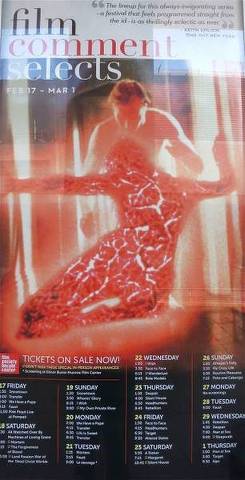
Last edited by Chris Knipp; 07-23-2014 at 07:03 PM.
-
Aleksandr Sokurov: Faust (2011)--FCS
ALEKSANDR SOKUROV: FAUST (2011)--FCS
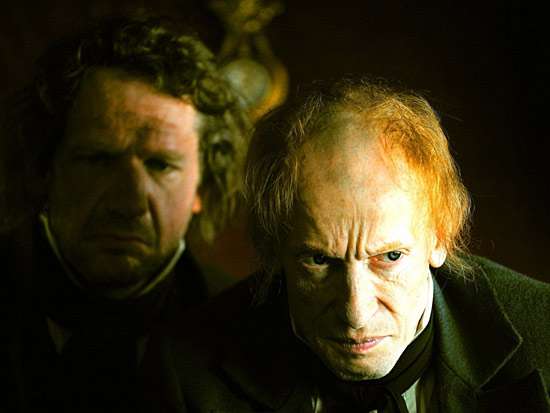
JOHANNES ZEILER AND ANTON ADASINSKY IN FAUST
Sokurov's very strange and visually remarkable version of 'Faust'
Aleksandr Sokurov's Faust won the top prize, the Golden Lion, at the Venice Film Festival in September 2011. Gavin Smith, the editor of Film Comment, introduced the FCS series and this film at the Lincoln Center Walter Reade Theater by saying that this was probably the only chance audience members would get to see it on the big screen. Indeed other than his big US art house success, the tour-do-force one-long-take trip through a museum with music conducted by Valery Gergiev film Russian Ark, Sokurov's films have rarely gotten theatrical releases Stateside. And Faust is not a likely candidate. The grubby opening sequence included hoisting up a naked cadaver whose guts fell out, which sent half a dozen people from the theater. When giving the Golden Lion, Darren Arronovsky announced that it was the kind of film that could change your life forever. Sokurov's films are remarkable as they are off-putting and strange. Most are haunting and hypnotic. Alexandra, (NYFF 2007)about an old woman who visits her soldier son at the front, is moving. The Sun (NYFF 2005), an incredibly sensitive portrait of the Emperor Hirohito in the time up to and after the Japanese surrender, is a hypnotic, revealing, and extraordinary touching portrait. Father and Son is as sensuous and homoerotic and strangely beautiful as any film about men ever made. Like many of Sokurov's films it exists in a foggy hyperreal dreamworld that is complete but only partly parallel to our own.
Faust, which like Sokurov's Moloch, is in German, announces in its opening titles that it is based on the work by Johann Wolfgang von Goethe, but interprets the legend of the man who trades his soul to the devil to gain knowledge in a very peculiar manner. This Heinrich Faust (Johannes Zeiler), who follows the traditional pattern in being a learned scientist, is linked up with a strangely annoying and grinning busybody of a devil with a pear-shaped body and scraggly reddish hair. He is a moneylender (Anton Adasinsky). Faust has become attracted to Margarete (Russian actress Isolda Dychauk), a pure young woman with pale skin and flaxen reddish hair, and it seems that his bargain is to give up his soul for a little time spent with her. Some "Faustian bargain."
The mood of Sokurov's Faust, as Variety reviewer Jay Weissberg has emphatically noted, is different from most of his other films in its ceaseless nattering verbosity. Mostly Sokurov's mood- and image-centric films contain few words but this one never stops talking. What with its voiceover from Faust or conversation between him and the moneylender, or the rambles of the moneylender, the soundtrack here keeps a constant chattering rhythm going like an outboard motor continually running. Sokurov thus creates and maintains a kind of peculiar energy and a sense of a world that is going on just beyond us, inside the screen so to speak. Sokurov has done this before, but this time the sense of a world that we can't quite penetrate is a little different. In other films we feel swept away (Russian Ark) or enveloped and hypnotized (Father and Son, The Sun). Here we are more alienated.
He counts this as the last in his tetrology about the corrupting effects of power. Those that I have seen (I'm missing Taurus, about Lenin) have little in common with each other. Moloch (1999) deals with Hitler in 1942, in Bavaria, and focuses on a visit to Eva Braun by Hitler, Goebbels, Goebbels' wife and Martin Bormann in which they sit around for several days talking about politics. The Sun, as mentioned, is an intimate portrait of the Emperor Hirohito.
What distinguishes Faust, which seems otherwise one of Sokurov's brilliant misfires, are the images and the mise-en-scène. Weissberg comments that the photography echoes Flemish painting and also folk art about witches. This may be so, but what seems even more striking is the way the director has recreated the look and feel of early photography. One could also not help but be reminded in the early sequence of Faust's laboratory of the photographs of Joel-Peter Witkin. And this gives a sense of how rich and elaborately staged and photographed the interiors and exteriors are and how convincing the people and costumes are in their sense of period. Beyond that, the framing of exteriors, the peculiarities of aspect ratio and focus, and the complex "gray" tonalities all build up the nineteenth-century look. Jim Jarmusch's Dead Man is an analogy, but here the effect is richer -- and stranger.
Manohla Dargis has commented on a shot as unforgettable. It's one where Faust is united with Margarete and he embraces her and they flip over together into a river. It's a dream-image, symbolic rather than real. And the whole film is best understood as what Dali and Bunuel might have done if they'd gone on working together and done their version of Faust. But there's just a gutted corpse here, no dead donkeys lying inside a grand piano. I still remember the late Graham Leggett introducing Sokurov's The Sun at a press screening for the 2005 New York Film Festival saying this was one of the world's great directors: the sheer boldness and conviction with which Leggett made the statement left a lasting impression. And somehow it still rings true.
Seen for this review as part of the Film Society of Lincoln Center's series, Film Comment Selects. Screening times:
Friday, February 17 at 8:15PM, Tuesday, February 21 at 3:15PM and Tuesday, February 28 at 9:00PM.
Last edited by Chris Knipp; 03-23-2012 at 06:01 PM.
-
James Franco: My Own Private River (2012)--FCS
JAMES FRANCO: MY OWN PRIVATE RIVER (2012)--FCS

A chance to see a lost actor at work
James Franco was fifteen when Gus Van Sant's My Own Private Idaho came out. He has said that it is his favorite film, it moved him, it helped shape him as a teenager. After he worked on Milk he went to see Van Sant and learned that he had kept 25 hours' worth of film footage shot at the time of My Own Private Idaho. Franco has written about the experience.
"We spent two days in Portland watching as much as we could. While we were watching, we discussed how Gus’s movies have changed in the intervening decades. His films now are much more spare in story and dialogue; they involve longer takes and fewer cuts. We were naturally led to wonder what Idaho would be like if he made the film now, and Gus offered to let me make my own cut."
Franco seems to have made three films, or maybe two that were combined. They've been shown at Toronto and put in an installation in LA at Gagasian Gallery, when Franco got Gucci to pay the cost of digitalizing the many hours of film Van Sant turned over to his use and the gallery agreed to present Franco's piece. The Gagasian installation is described in a Guardian blog, "James Franco brings River Phoenix back to life,"and now appeared at the gallery across from the entrance to the Walter Reade Theater at Lincoln Center in New York where the Film Comment Selects series is shown. This was a shabby-chic version of an AA meeting, with scattered mismatched camp chairs and romantically tacky hanging gold and orange drapery, a table with a coffee urn and paper cups, a color film projected on a big screen at one end of the room and a small screen at the opposite end high up with a film in black and white on a monitor. (The latter turns out to be the Shakespeare material that Franco chose to leave out.)
I did not go to the Film Comment Selects' late evening event at which these were handsomely projected in their combined form on the really big screen with a Q&A by Franco at the end, because this was sold out. But I got the feeling from the faux AA meeting installation, which was one of sadness mixed with respect for the talent of River Phoenix. Van Sant's film gives us fragments of a lost life, love, hope, comical sad hustles, love and disappointment. River Phoenix delivered other notable performances. At a memorial service after his death Sidney Poitier, who worked with him on one of his films, called him "incandescent." It's surprising to see that what would seem to be a child role, Stand by Me, comes only two years before Phoenix played a precocious, gifted youth in Running on Empty, and a mere five years before the layered complexity of My Own Private Idaho.
It's interesting that James Franco has done these pieces and Van Sant let him do them. Whether or not there are more long takes in Franco's edits, Idaho was a highly improvisatory production with a lot of people hanging out and living approximations of the dissolute lives the film chronicles. (This is brought out more because Franco stressed the documentary aspect of the film footage.) Rumor had it that there were a lot of drugs and some said the atmosphere gave Phoenix a push toward the downward path (his death from an overdose came two years later). But what the extra takes and footage show of Phoenix is of him living the sensibility of his character, Mike, the narcoleptic gay street hustler. Phoenix had in some sense lived on the street, since he and his siblings reportedly entertained on the sidewalk to make money when very young, and this is how River became a performer, as a street singer and busker. We can see Phoenix turning talk about nothing into seamless rifs on Mike's sad aimlessness and longing for home and love. We can see him turning stage business over pasta at the table in Italy to an expression of his jealousy and sense or rejection. He is so expressive you hardly need the movie, or the dialogue.
In a page Franco published in The Paris Review he talks about the many alternate takes that go into any movie. Mostly the ones not used are thrown away. But "sometimes—as when they feature an actor like River Phoenix in a film like My Own Private Idaho, the best of his generation giving his best performance—every scrap is gold." So here simply we have some scraps of gold gathered by James Franco with the collaboration of the original filmmaker, Gus Van Sant.
The interest for students of acting is to see a gifted actor "in character." It's playacting so good you can't see when it starts and stops.
While the installation went on for several days, My Own Private River was a one-time event of Film Comments Selects at the Walter Reade Theater of Lincoln Center.
Sunday, February 19, 2012 at 9:00PM.
James Franco attended and participated in a post-screening Q&A.
There is a Film Comment Q&A with Franco avaiable online . Franco says Phoenix in the film (and rushes) often seems like "a cross between James Dean and Charlie Chaplin."
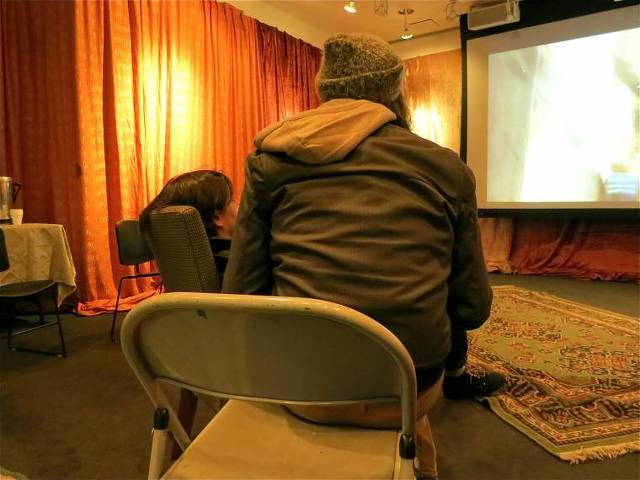
Visitoers hanging out in the "My Own Private River" installation, Walter Reade Theater Feb. 2012, seem like
Gus Van Sant characters.
Last edited by Chris Knipp; 03-07-2025 at 10:58 AM.
-
Hirakazu Koreeda: I Wish (2011)--FCS
HIRAKAZU KOREEDA: I WISH (2011)--FCS

Oshiro and Koki Maeda in I Wish
Watching bullet trains, choosing the world
In 2004 Koreeda made a wonderful but sad film about children, Nobody Knows. I Wish is another one, nearly as fine, but much happier -- though again it has children dealing with unreliable parents (just not as bad). There are superb scenes in which kids are charming and real. But I Wish moves around much more than Nobody Knows. In that one, four siblings are abandoned together by their radically irresponsible mother and must try to survive in their apartment on their wits. This gives Nobody Knows, perforce, unity of place. I Wish skips around, as it must, because this time there are two brothers who are now living with separate parents. At one or two points I Wish says a little bit too much in the mouths of babes, but it also contains moments of such beauty you wish they would never end. Probably some of the magic comes from the fact that the film stars real-life brothers Koki and Ohshirô Maeda who already had their own sibling comedy act, Maeda/Maeda.
Are Japanese kids cuter and happier than other children? Sometimes it seems so. Whatever the case, these qualities feed into the magic moments that abound in Koreeda's new film. I Wish isn't an unqualified success. It may ride too much on its cuteness and its magic. Or Koreeda may have been too reluctant to cut any of the cute or magical moments, which -- due to his success as a director of children and documentary filmmakers and the charm of his young cast -- kept multiplying. As a result his film meanders and sprawls. But it's possible meandering and sprawling are Koreeda's way no matter what his subject is. He isn't a director who likes to move fast. Note how patiently he wanders through the long summer day in his 2008 Still Walking. The meandering is deceptive. The film builds, and when it's got all its force together it hits you with a quiet emotional wallop. Koreeda creeps up on you.
But I Wish is deceptively random-seeming and deceptively simple and "accessible." There is as much order here as there is complexity. This may be Koreeda's most accessible film but it's up with his best and most original work. And what it's all about may not become clear till later.
The story focuses on a child's urban legand: the idea that if you can see two new bullet trains crossing paths the wish you make then will come true. The two brothers talk on the phone. They're apart now because their parents couldn't get along. Their mother Nozomi (Nene Ohtsuka) found their musician father Kenji (Joe Odagiri) totally unreliable, so she moved back in with her grandparents (Isao Hashizume, Kirin Kiki) to work in their little supermarket as a cashier, taking the older brother, Koichi (Koki Maeda), a sixth grader. The small but lively Ryunosuke (Ohshiro Maeda) goes to the big city of Fukuoka with his dad, a rock musician who's never quite successful enough to do without other work but can't stick to a conventional job. We get a few looks at the parents' former squabbles, but mostly we focus on Koichi and Ryo. It seems as though it's Koichi who most wants to get back together. A chubby, perhaps more staid chap, Koichi may be a bit jealous of Ryo's new friends, who include the prettiest girl in class, Emi (Kyara Uchida). He chafes at life with the grandparents, and is annoyed by the volcanic ash of Kagoshima, where he now lives. Obviously life with their laid-back dad and his band-mates is cooler, even if life with mom is more reliable.
Koreeda is skillful at managing three plots: the life of Ryo, the life of Koichi, and their project to meet midway to observe the two bullet trains and make their wishes, which finally takes over as a group "road picture" with a subtle kind of "resolution" that avoids conventional feel-good aspects with moments that may make you cry but none of the saccharine tear-jerker outcome ordinary filmmakers would have made with this plot outline.
Part of the time is spent following Koichi and his classmates and their dislike of a teacher (Hiroshi Abe) and crush on a school librarian (Masami Nagasawa). Meanwhile Ryo becomes the pet of a group of girls including an aspiring young actress s (Kyara Uchida) whose failed actress mom (Yui Natsukawa) keeps telling her daughter she will fail. Back with Koichi, grandma is learning hula dancing and grandpa and his cronies drink and tweak an old-fashioned (comically tasteless) cake recipe which some think can be sold as a novelty tie-in with the new bullet train.
None of this matters so much in dramatic terms except for the way it all creates a three-dimensional world going in various directions linked by the bullet trains and the boys' bullet train project. The scenes of the children are particularly sprightly and winning, and the progress of the film is punctuated by the linking cell phone chats between the two brothers. The wish-making meeting involves fellow classmates, money-raising (the tickets are expensive), permissions for a 24-hour absence from school, and a lot of logistical planning. The wish-making project takes on a metaphorical meaning: the journey becomes the destination. Making the wish as the bullet trains cross paths turns into one of those childhood myths, like the tooth fairy. In the event, the boys find themselves discovering a new outlook, or choosing "the world," as Koichi puts it. But that thought and those final sequences are just something to hang your hat on. I'm sure the deepest truths of I Wish are buried in the laughter of classmates, the cell-phone conversations, or Ryo's fava bean-growing. This is film that will obviously profit from repeated viewings.
The score by the soft rock group Quruli may seem more ingratiating than necessary, but it helps underline the youthful good spirits that prevail; maybe Koreeda is consciously creating an antidote this time to the deeply downbeat feel ofNobody Knows. The reassurance of I Wish is that parents in modern urban society can part without the children's being left abandoned or desperate. These kids are good at fending for themselves but they also have good adult support.
I Wish (128 minutes, cinematography by Yutaka Yamazaki) debuted at Toronto September 2011 after a June theatrical release in Japan, and has been at numerous other festivals, including Rotterdam. It enters French cinemas in April 2012. It was also included in the Film Society of Lincoln Center's 2012n Film Comment Selects series shown at the Walter Reade Theater, where it was screened for this review. It showed to the public as part of the series at these dates and times:
Sunday, February 19 at 6:15PM and Monday, February 20 at 8:45PM.
Koreeda's I Wish is being distributed in the US by Magnolia Pictures and will open in New York at Lincoln Plaza Cinemas and Angelika Film Center May 11, 2012.
Last edited by Chris Knipp; 09-16-2013 at 10:20 PM.
-
Mathieu Kassovitz: REBELLION (2011)--FCS
MATHIEU KASSOVITZ: REBELLION (2011)--FCS
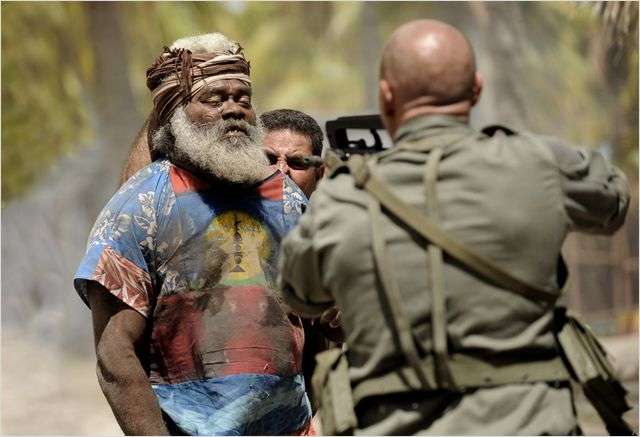
Kassovitz's smart actioner
Mathieu Kassovitz's Rebellion, which he directs and stars in, is about the revolt and hostage-taking that occurred in 1988 on the tiny Pacific island of Ouvea in New Caledonia that was put down by its French rulers. This is an intense action film about shocking historical events -- one that effectively goes beyond the action format to show how politics trumps military and diplomatic considerations. Kassovitz has to that extent made a war movie for smart people. and this isn't a crude polemical piece but a deftly executed film with high production values full of elaborate set pieces and showing a superb and natural sense of place. Note however the limitations of personal POV: this is the arguably one-sided account of one man, a main player (as he saw it anyway) and based on his published memoir of events. The good man surrounded by military puppets is a well-told tale that provokes thought -- and one of the best new political films from the French in some time as well as a great leap forward for Kassovitz as a filmmaker -- even if it is not a work of sublime complexity.
We begin with the violent finale. Then we go back to the beginning, from the narrator's point of view when GIGN (French national police intervention group) Captain Philippe Legorjus was sent out to New Caledonia with his personal team because locals who rebelled independently (separate from the French-branded "terrorist" independence insurgents, the FNLKS -- Le Front de libération nationale kanak et socialiste) -- had taken some hostages in two places and killed a few people in the process. Negotiation in such crises is Legorjus' job, and he is sent the 23,000 kilometers with his own team. As he sees it since New Caledonia is French territory the rebels are French, and should be treated with the respect accorded French citizens. The action is limited and he has no doubt -- this remains true to the bitter end -- that it can successfully be contained by negotiation.
But it's 1988 -- in the middle of the 12-year socialist presidency of François Mitterand when opposition from the right is virulent. An election is coming very soon. Right-wing PM Jacques Chirac leads a conservative cabinet. The Ouvea revolt and hostage-taking becomes a tool of their conflict. Both sides must take a strong position on it. And this will be fatal for Legorjus' negotiations.
Kassovitz's film shows excerpts from a debate between Mitterand and Chirac that took place in the middle of the events. The two politicians take opposing views, but the film overlaps their remarks after a while depicting them as merely a political blah-blah-blah. The point is that the issue has to be resolved before the election and to do that, negotiating would take too long. Politics intervenes and negotiating is doomed. He doesn't quite know it yet, though Legorjus and his team arrive to find the French army already deployed in alarming numbers, for a tiny rebellion (ten to one, anyway): heavily armed intervention by special assault troops is already a foregone conclusion.
It's a tribute to Kassovitz's well-executed film that it tells a complicated step-by-step story over a ten-day period with great clarity and including action on many levels. And this involves meetings with the main leader, the hostages, and many communications back and forth by Captain Legorjus with the local military in charge, the government minister sent to New Caledonia, the general to whom he must report, and CIGN government liaison in Paris. He also meets with the leader of the insurgent Kanaks FLNKS. The leader of the rebel hostage-takers, Alphonse Dianou (Iabe Lapacas) is depected perhaps as too gentle and sweet to be true. But you have to grant that Kassovitz is making a smart person's action movie but still an action movie, and this is not a mini-series: he turns in the whole story in a fast-moving 135 minutes, so there is come simplification. The complexities of the New Caledonian independence moviement are left aside. A newcomer to the topic might think what had gone on for a century had just arrived last year.
Advocates of the government or even of the CIGN, who might wish to argue they acted correctly and not simply under pressure are not so pleased with Kassovitz's anti-colonialist analysis, but the basic principle is a universal one. Issues are crudely resolved to satisfy the needs of an election. White soldiers quelling a non-white rebellion 23,000 kilometers from home are not likely to be gentle. They tortured. They massacred. Captain Philippe Legorjus fought a desperate race against time to carry out negotiations before the attack and almost got killed doing it, but -- spoiler alert! -- in the end (it's where the movie begins) he didn't get to do the job he had been trained to do. As Legorjus, Kassovitz has that same neutral, easy-to-identify-with quality ha had in his iconic early role as the young con man in Jacques Audiard's early A Self Made Hero/Un héros très discret. Other good cast members: Malik Zidi as JP Perrot as Legorjus' second in command; Alexandre Steiger as Jean Bianconi, a local negotiator; Sylvie Testud as Legorjus' wife; and a host of Kanak people and Frenchmen who make the scenes come alive and look right.
Rebellion is a misnomer. The French title is L'ordere et la morale, Order and Morality, an ironic tag that leaves us with a tonic dose of frustration instead of the usual catharsis. This is Kassovitz's most significant directorial effort since his important 1995 film about class in France, Hate (La Haine), and this time he is working with a bigger concept and a bigger budget and project.
Rebellion is a film that debuted at Cannes and also showed at other festivals, including Toronto and London. It opened in Paris November 16, 2011 to very good, if not great, reviews (Allociné 3.2); some critics understandably see the film as fine, but flawed; perhaps some did not see how much is done well here, but they did see that Kassovitz produced a creditable effort after serious missteps and the entertainingly lurid The Crimson Rivers. Rebellion was also included in the Film Society of Lincoln Center's series, Film Comment Selects, where it was screened for this review (Feb. 29, 2012).
-
Nadine Labaki: Where Do We Go Now? (2011)--ND/NF
NADINE LABAKI: WHERE DO WE GO NOW?--ND/NF
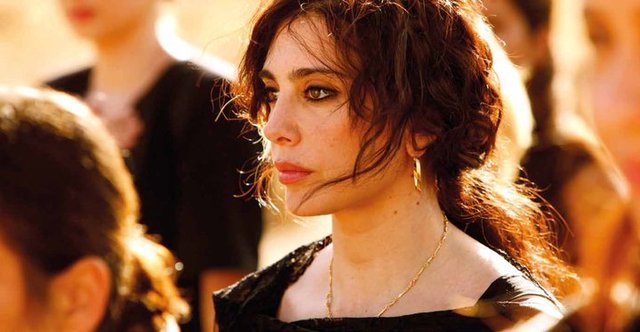
NADINE LABAKI IN WHERE DO WE GO NOW?
A nice fantasy
Lysistrata with song and dance and hashish cookies is what Nadini's sophomore effort is, a benign fantasy of how a Lebanese village might stop its deadly Muslim-Christian clashes if all the women just switched religions and hid their men's weaponry after getting them very stoned. The film is a charmer -- it's sort of as if the gut-wrenching Incendies were redone as a Don Camillo tale directed by De Sica with help from the Taviani brothers -- and it's the kind of movie you get if you mix up handsome young men, pretty women, lusty old ladies and chubby geezers in a grab bag of different physical and personality types located in a quaint hillside town. Labaki herself is one of the stars and she's a looker. (Her star-crossed would-be Muslim beau is played by Claude Baz Moussawbaa.) There's able cinmatography by dp Christophe Offenstein and plasing music by Khaled Mouzannar. The screenplay is from Thomas Bidegain, who collaborated with Jacques Audiard on the script of The Prophet.
Everybody gets together, plays together, sits in the localcafe together, watches a scratchy TV together. Just outside town there is the village cemetery, full of handsome young men, with the Christians on one side and the Muslims on the other. Though the women have taken over there's still a pair of corpses to be buried at the end, one Christian and one Muslim, and that's what the title is about. Since they women have switched religions ("I'm on the other side now"), which side do the coffins go to? it is a nice fantasy.
Where Do We Go Now? has hectares of charm and local color. Its Lebanese Arabic is the saltiest language imaginable, especially what comes of those feisty old dames' mouths. There is some Russian and English too, which comes from a totally unnecessary, and not at all glamourous, little troup of Russian women brought in to entertain and distract the men. As if we needed another distraction. Labaki likes to keep new stuff happening. She showed that in her debut, Caramel, which was less ambitious and a little more successful, and told a ronde of love and family stories centered on the employees and customers of a Beirut Beauty parlor. The only trouble with this method is that the audience never identifies much with any one person. In this new film we may have trouble even identifying members of the ensemble at times, especially with the young men, who don't wear outfits to tell us which religion they belong to.
The lack of strong emotion is more evident when the sectarian strife built into the Lebanese DNA takes its toll and the tone turns tragic. As Alissa Simon of Variety wrote, this "genial and at times genuinely inventive" film tickles the funny bone' but never quite 'taps the emotions.' She also notes "problems of tone, pacing and performance." Nonetheless when it played in Paris last fall (as Maintenant on va où? it was well received (Allociné 3.7, with even more enthusiasm from the public), and the charm goes a long way. This was also Lebanon's entry into the competition for the Best Foreign Picture Oscar, but not a finalist.
I originally reviewed Where Do We Go Now? when I saw it in Paris (Oct. 27, 2011). As I pointed out, reviewers with several of the more sophisticated French publications were cunimpressed at Sept. 14 release time, though though did play in a lot of locations (and Caramel had had a French run in 2007 and a US one several years later). This is a feel-good movie with enough likability to carry it through a theatrical run, and may be enjoyed for years to come, but though it has lots of color, many of even the best scenes are derivative and not memorable.
Where Do We Go Now is included in the March 21-April 1, 2012 New Directors/New Films series, put on in New York by the Film Society of Lincoln Center jointly with the Museum of Modern Art. It's the opening night film. Showtimes:
Wednesday, March 21st | 7 PM | MoMA
Wednesday, March 21st | 8 PM | MoMA
(Where Do We Go Now? has been picked up by Sony Pictures Classics for US release, as has the other press screening of today, Garth Evans Indonesian-language martian arts action film The Raid.)
Last edited by Chris Knipp; 07-23-2014 at 07:14 PM.
-
Gareth Evans: The Raid: Redemption (2012)--ND/NF
GARETH EVANS: THE RAID: REDEMPTION (2012)--ND/NF
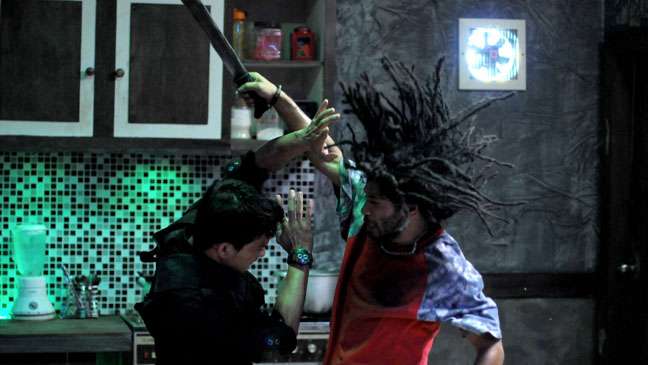
The ultimate fight picture?
The Raid runs for 100 minutes. Be prepared. Most of it is violent fighting in a dark ghetto building 15 stories high. Fighting with automatic weapons and pistols but mostly with machetes and knives and hand-to-hand, to the death, on and on, to the last man. This is as dark, intense, violent, and extreme a movie as you will ever be likely to see. And for about 90 minutes you are trapped in the halls and apartments of that grey, dingy building with vicious and desperate men. If that appeals to you, have at it. If not, please don't come to watch this movie.
A SWAT-style attack squad of policemen comes to rout makers of illegal drugs housed on the top floor of a tall building. But some of the squad are tyros, inexperienced in such raids. And they are expected. The building is dark and dingy but fitted with a full system of security cameras. It also has a speaker system. And it seems to be crawling with lithe, long-haired men in loose, greasy T-shirts, carrying long machine guns and out to kill anything that moves. Not only are many of the policemen quickly killed, but for the rest, the escape route seems blocked. When the cops have been decimated and only the strongest survive, the lithe bad buys keep coming on one floor after another, carrying knives and out to kill. They keep on coming and coming. Only a handful of cops survive and make it to the top floor. And their fight is the longest.
"I am the guy that makes stunt performers take multiple kicks to the head for what I hope is a captivated audience," says Gareth Evans, a Welshman who as a child wanted to be Jackie Chan. He was later a fan of Die Hard and Assault on Precinct 13 -- "films that used a single building for unyielding cinematic geography while creating feature-length tension." Then he went to Indonesia and learned about Pencat Silat, a traditional kind of martial arts fighting using the body and blades and teamed up with Iko Uwais, a young, almost baby-faced champion of the sport. He first starred in Evans' debut, Merentau. The Raid will seal Evans late-night martial arts movie cult status. In The Raid, Uwais plays Rama, a young cop with a pregnant wife. And then there is Joe Taslim, who plays Jaka, and Yaya Ruhian, who plays Mad Dog.
The aim is to bring down the calm, sinister drug lord on the top floor, Tama (Ray Sahetapy). He watches the battle with Andi (Doni Alamsyah) and Mad Dog on his battery of screens. A complication, besides the fact that a lot of the cops are unfit for this kind of urban warfare, is that the raid instigator, Lt. Wahyu (Pierre Gruno), is corrupt and may have devious motives that can lead to the failure of the operation.
While Tama's ragtag army has downed most of the cop squad, it emerges that Rama is a relentless superman. After a while the focus is on his continual downing of opponents. There is also a wounded cop whom a building resident with a sick wife takes in, hiding him and Rama till Mad Dog breaks in.
Evans skillfully structures the action (which was created interactively, the stunt men and martial artists creating their fights according to what he calls "a D.I.Y. method of fight choreography," with the film team, cameramen, and editors) so that it rises and falls, with changes in rhythm and what he calls "breathing space" -- calculated pauses so the audience can catch its collective breath. For the faint of heart this is simply unpleasantness, but for those who like martial arts movies, this is a new kind of pleasure. The fight choreography is superb. Pencat Silat is a rough kind of fighting, with running and tackling and improvisation of weaponry. There is also some judo, where brawn is more a feature. There are leaps and twists. Moti D. Setyanto's production design makes use of the building, where holes are punched so men can jump or climb between floors, and there is the feel of an endless but inescapable labyrinth.
It's awesome, it's relentless, and toward the end it's a bit absurd, how several guys can get beaten up, then untied, and fight tirelessly in a threesome for endless minutes, then run away. The most tireless bad guy fights for minutes with a candle driven into his throat. There is a satisfying finale involving capture of the crime boss, punishment of the corrupt cop, and a reunion of brothers who are on opposite sides. All ready for Berandal ("Thug"), the sequel, which is coming, with Uwais again as Rama. The director sees The Raid now as the first of a trilogy. Obviously Evans, whose team for shooting, editing, sound design and two music tracks for Indonesian and western audiences is crack, is in deep debt to Hong Kong. This would not exist without that. But the dark Kafkaesque ironies of the action evoke Park Chun-wook and the Korean revenge film of recent decades too.
The Raid: Redemption or Serbuan Maut presented at Toronto, followed by Sundance and SXSW. It has been picked up by Sony Pictures Classics. US release will be March 23, UK May 18, 2012. It is included in the MoMA/Film Society of Lincoln Center New Directors/New Films series, to be shown:
Thursday, March 22nd | 6 PM | MoMA
Thursday, March 22nd | 11 PM | FSLC
Last edited by Chris Knipp; 03-05-2012 at 09:35 PM.
-
Mohammad Rasoulof: Goodbye (2011)--ND/NF
MOHAMMAD RASOULOF: GOODBYE (2011)--ND/NF
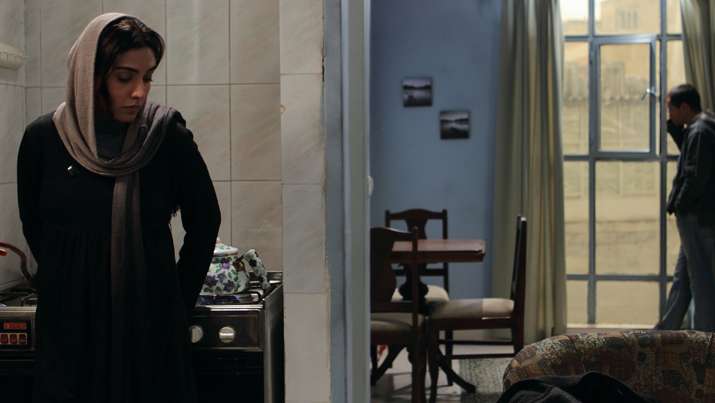
LEYLA ZAREH IN GOODBYE
Another quintessential Iranian picture
Mohammad Rasoulof, who has done intriguingly poetic films like Iron Island (2005) and The White Meadows (2009), has come down grimly close to home with this claustrophobic, cold study (everything is blue gray and nearly everything is close up and indoors) of a woman lawyer trying to get out of the country. Like Rasoulof himself, she is having visa problems. Like the woman in Asghar Farhadi's recent much honored A Separation, she wants to leave Iran. Her life has been shut down by the regime. Her right to practice law has been taken away and she has lost her cases. Her husband, a journalist, has had his newspaper shut down and is operating a crane on an industrial construction project in the south of the country. She has gotten pregnant. She was told to by a man we never see, who takes money to help people leave. And it turns out late in the film that her child will have Down Syndrome. What a nightmare! But she only cries once, and that is muted, her shoulders shaking as she lies face down on the bed.
Leyla Zareh, as the lawyer, with her beautiful long-suffering face, looks like Ingrid Bergman. It's good that she's beautiful, because we have to spend a lot of time looking at her. Her little apartment contains nothing but her and a turtle. Across from it is the airport, and that and the turtle who escapes after she puts it in a larger container and apparently dies or disappears, are blatant in a way that Rasoulof has not been before. His experience has robbed him of his detachment and his cinema has lost its poetry.
Goodbye is a punishing film, impeccably made, perhaps, with its clean looking digital images, with a few nice shots and enough specific detail to make you, if you can stand it, pay attention. But it's basically very thin on artistry, though the stress on chilly office putdowns make this seem another quintessential contemporary Iranian film. After seeing it at Cannes Mike D'Angelo gave it only a 49 and wrote: "More political statement than movie. Even as a movie it’s on shaky ground, with the symbolic turtle and so forth." But it is a movie, a conventional movie, almost an instructional film. (If it were only that it would be a notable one, because instructional films don't usually get actors as good-looking as Leyla Zareh). No, it's a little more than that but a lot less than Jafar Panahi's This Is Not a Film, which was also at Cannes, and linked with it because they were both smuggled in and added to the festival at the last minute. Both men were arrested with more than a dozen others at the same time, and jailed, but unlike Panahi, Rasoulof has not been officially banned from making films. Ironically, Panahi, banned from filmmaking, made a film that is self-referentially witty and ironic and strong. Rasoulof, not banned, has made someting blatant and obvious and tedious. Farhadi, well, he has made a film that to me is annoying, but it is intricate and neatly constructed and a picture of Iran's problems that is, relatively, warm and full of life, but to say that is to see just how chilly and empty Goodbye is.
Commenting from Cannes on mubi's online Notebook, Daniel Kasman seems to share my dissatisfaction. He finds Goodbye repetitious, lacking in deput, "a cyclical dirge," and sees it as "cloaked and variably choked by both the clandestine nature of the film's production and the hushed and desolate story it tells." Yes, we must applaud both Panahi and Rasoulof for their smuggled-out cries of protest against their country's repression. But Panahi's film is intriguing and this one is numbing. Simon Abrtams calls it "too literal and pat." Nonetheless, predictably, there were raves, and Alissa Simon in Variety predicted that "fest and niche arthouse play can be expected."
Goodbye was also released in France in September and shown at Toronto and in other festivals. It was watched for this review at a press screening for the MoMA-Film Society of Lincoln Center New Directors/New Films series.
Goodbye (Bé omid é didar, in Farsi, 104 min.)
Thursday, March 22nd | 8:30 PM | FSLC
Saturday, March 24th | 1:00 PM
-
Terence Nance: An Oversimplification of Her Beauty (2012)--ND/NF
TERENCE NANCE: AN OVERSIMPLIFICATION OF HER BEAUTY (2012)--ND/NF

NAMIK MINTER AND TERENCE NANCE IN AN OVERSIMPLIFICATION OF HER BEAUTY
Seduction through analysis of seduction
Terence Nance is a charming young African American man with big hair and a big heart. He wanted to give the latter to a young lady called Namik Minter, and this feature film, said to have been 3 hours long at one point, then honed down to 94 minutes through help from Sundance, was designed to woo Namik by delineating the nature of his romantic affection for her (he tends to fall into flowery formal language when talking about his feelings and his romances). The many, sometimes too many, voiceovers, often in the second person, describe and analyze. The topic may seem repetitive, but Nance makes it interesting by the appeal of his looks and personality and by the constantly varying visual styles, by interrupting and subdividing his visual texts, and by including by way of further description and analysis many animated film passages, these executed differently too by a variety of hands, following his storyboarding. If Terence Nance didn't succeed in wooing Namik, he may very well seduce you with this highly original first feature, which is bursting with ideas, human warmth and creative energy.
Terence grew up in (by his own account in the film) an exceptionally warm and healthy family -- which (though he does not mention this) was in the strong black community of Dallas. He thereafter received his undergraduate degree from Northeastern University in Boston, Mass., made his first film while studying at Cape Town University in South Africa and received his MFA from New York University in 2007. He also lived in Paris for two years, 2007 to 2009, and now lives in Brooklyn. Some of the action, including the meetings with Namik, appear to take place in NYC. He shows himself working as a street musician with a guitar and describes himself as having a hard time waking up to get to work on time.
But the central event is an evening when he had been expecting Namik to come to his place after work, when he learns she isn't coming. In an interview online with an LA blogger called Rinny Riot he says, "I had what I thought was a complicated situation with a woman, that inspired me to write the film. So my original intentions probably amounted to some sort of need to consecrate or validate a dying romance." The original smaller film-within-the-film was called "What Would You Feel?" It visually, in multiple alternate versions, restages the expeience of rushing home from work and learning that his would-be beloved (who turns out to be Namik) is not coming that evening and each time ends with the rhythmically repeated question, "What would you feel?"
He got Namik to play herself. And somehow this takes her by surprise, or the experience of seeing the reenactments on screen before an audience of a hundred people, including many of her friends, is a bit of a shock to her. He interviews her about this experience during the course of the larger film. All of this and the complex animated films-within-the-film can be seen as wooing Namik, but in the end he sums it up by saying "in simple English, 'I got friend-zoned.'" He has already discussed at length how little a young man wants a young woman in whom he is interested to consider him a "friend."
The Variety interview suggests Terence adds "vaguely New-Wave style" to his arsenal of seductive techniques, and this is true even if unintentional (the two years in Paris may contribute). At any rate the force of this young filmmaker's potential surely comes from the "omni-directional creative energy" he describes having when in film school he was spray stenciling "FLY" all over the city, making T shirts, and making music, and the fact that he doesn't pigeonhole himself as a director.
In the film he moves on from the incident, which he thought he could depict in five minutes but ran to three hours and took up years of his time, to (justifying the time spent) a film that analyzes an archetypal "romantic-ish" relationship, and also to goddess-worship, to the valuing and use of "emotional memory," in other words, to romanticism itself.
In MissRiot's blog interview Terence Nance is articulate and righteously concerned about strengthening the creative role of African Americans in film. "Learn your craft to competency but learn your voice to mastery," he says, addressing aspiring filmmakers of color. He seems to be doing that, and for all we know he might be the next Spike Lee. This also reminded me of another strong memorable young black film about romance, Barry Jenkins' 2008 Medicine for Melancholy (SFIFF 2008).
An Oversimplification of Her Beauty debuted at Sundance, then was shown at Rotterdam. In March it shows in the MoMA-Film Society of Lincoln Center series New Directors/New Films on the following dates:
Saturday, March 24th | 4:15 PM | FSLC
Monday, March 26th | 9 PM | MOMA

TERENCE NANCE PROMOTIONAL PHOTO
Teaser for the film: here .
Last edited by Chris Knipp; 07-23-2014 at 07:16 PM.
-
Roschdy Zem: Omar Killed Me (2011)--ND/NF
ROSCHDY ZEM: OMAR KILLED ME (2011)--ND/NF
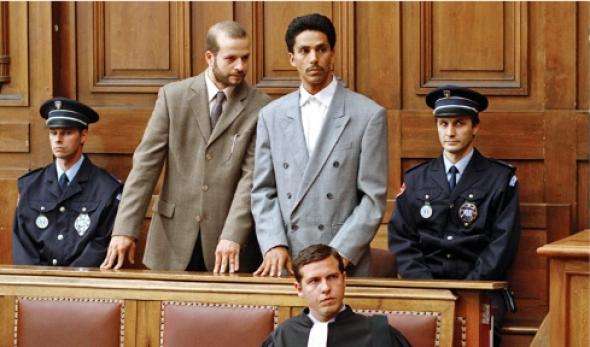
NACER CHERNOUF, SAMI BOUJILA IN OMAR KILLED ME
Injustice to an Arab in a French court
Omar Killed Me/Omar m'a tuer is a good but not great film about a familiar theme: a man framed for a crime he didn't commit, whom people struggle to exonerate. There is an angle of class and racism because the man rushed to a conviction in a French court is a poor Moroccan immigrant, illiterate in Arabic as well as French and hardly able to speak or understand French. The most vivid message is how helpless an inarticulate person must necessarily be in a courtroom, despite in this case having famous lawyerrs. He is put away for the murder of a wealthy widow for whom he worked as a gardener. The veteran French actor Roschdy Zem, himself the son of Moroccan immigrants, chose this theme for his very creditable, but not dazzling directorial debut. One can see why he chose this subject, but one wishes he had waited for something better. Sami Boujila, another big French actor of Arab descent (in his case Tunisian) plays the role of Omar Raddad, the protagonist with great understated power. The costar is the ubiquitous Comédie Française star Denis Podalydès, cast as the slightly oddball writer Pierre-Emmanuel Vaugrenard, who does a muckraking book about the case that helps get Omar early release from prison -- though he has still not been proven innocent, because the court won't allow the case to be reopened. DNA checks might exonerate him, as it has US death row prisoners in recent decades. It's a story that does not end with a bang.
There is something iconic about Sami Boujila in this film, with his erect posture, his pompadour, his broad-shouldered, cheap suit jacket, his blank, stoical stare. The challenge of the role is that Omar Raddad isn't initially at all an interesting character. He's quite inarticulate in French at first, and tight-lipped in Arabic too. He emerges slowly. So does the case, and its secrets never come out. Yes, it's obvious that Omar isn't proven guilty. The blood-message, "Omar m'a tuer," in ungrammatical, probably written by a strong, untutored murderer rather than the wealthy, well-read lady victim. No fingerprints were taken; there is no real forensic evidence. The murdered woman was inexplicably cremated (probably against her wishes) so further investigation of the murder could not be done -- and so on.
As we would expect, Zem's gets good performances. Boujila is quietly charismatic. Raddad's torments and his desperation in prison, his relations with his father and his family during visits and on his release, provide the main human interest. Vaugrenard is a mildly interesting character, with individual touches, including relations with his working-class girl assistant (Salome Stevenin) that have an edge: but this is a sideshow. The lawyers are important in getting Raddad's pardon too, but they don't get in-depth treatment. The main one, Maitre Verges (Maurice Benichou), one of France's most famous defense lawyers, hardly needs filling out here since his work was examined in Barbet Schroeder documentary Terror's Advocate.
There are lively courtroom scenes. But the weakness is that the effort to prove Omar innocent isn't made suspenseful enouugh. The story itself has this weakness: that Raddad has not been provben innocent, so there's no final payoff, like the accuser's draw-dropping court recantation in another current French miscarriage of justice film, Vincent Garenq's Guilty (Rendez-Vous with French Cinema 2012). Omar Killed Me feels like a great story -- only it's not quite. Zem's "pacing of a thriller" doesn't quite work because this isn't quite a thriller. It's muddled. The film approaches Omar with total empathy, but the failure to prove his innocence conclusively spoils the story of injustice. And the empathy clouds the sense of a mystery to unravel.
A collaborator on the screenplay was Rachid Bouchareb, who co-wrote and direced all the big French-Arab movie actors in Indigènes/AKA/Days of Glory, the 2006 film about the Arabs who fought for France in WWII. The film is based on several books, including Omar Raddad's memoir, Pourquoi moi? (Why Me?). The many cooks did not enhance the broth.
Omar Killed Me opened in France June 22, 2011, to good review (Allociné 3.3); however some key publications, Le Monde, Libération, Télérama, Cahiers du Cinéma, Les Inrockuptibles, were less favorable. It has been in several festivals, including Toronto and Glasgow.
Omar m'a tuer (85min.) is included in the 2012 MoMA-Lincoln Center New Directors/New Films series shown as follows:
Saturday, March 24th 2012 | 6:45 PM | FSLC
Sunday, March 25th 2012 | 7:30 PM | MoMA
Last edited by Chris Knipp; 03-07-2012 at 03:49 PM.
-
Adam Leon: Gimme the Loot (2012)--ND/NF
ADAM LEON: GIMME THE LOOT (2012)--ND/NF

TASHIANA WASHINGTON AND TY HICKSON IN GIMME THE LOOT
Girl-boy graffiti duo wander the summer city
Malcolm and Sofia are two young graffiti artists from the Bronx. The novelty is that they're a girl and boy team. There's a potential romance here that never flowers and remains at the teasing level of friendship. Nothing else quite gets fully off the ground either in this good-natured, naturalistic film ramble through a couple of days in the heat of a NYC summer when the pair are trying to raise $500 for their project to write on or "bomb" a giant apple that is used in Mets games. They figure if they can "bomb" it when it pops up to signal a Mets score, it will be the ultimate coup. Together and apart the pair try various ruses, trying to steal stuff and sell stuff to raise the dough.
As Sofia and Malcolm, Tashiana Washington and Ty Hickson are attractive and natural. It's a pleasure to watch them interact and riff off each other. But the overall action is only so-so. This is like the Larry Clark of Kids and Wassup Rockers without the sex, the edge, or the variety of colorful characters -- in short without much of what makes those Larry Clark films watchable. Malcolm's encounter with a rich girl (played by Bowdoin student Zoe Lescaze) is the most interesting and Clark-esque digression. Viewers may be less willing to put up with the constant profanity without the Clark edge. The slightly faded-looking photography by Jonathan Miller does the job well, and it's particularly impressive in such a low-budget enterprise how smooth the soundtrack of dialogue is as the characters move through crowds, ride subways, and so forth, and even when they are off in the distance.
Adam Leon has said that the greatest challenge he faced was in the casting and that once that was done, he was halfway home. And indeed Washington and Hickson are attractive, winning, and natural. Because of the hot summer NYC 'hood setting and the teen romance in the air I was fleetingly reminded of Peter Sollett's Raising Victor Vargas , but that coming of age tale, deeply rooted in the Dominican community, with family and romance, has more to offer.
Leon has mentioned the naturalistic 1953 NYC picture Little Fugitive as an inspiration. Another good one might be Shane Meadows' 2008 London 'hood ramble Somers Town, which sings and charms. Maybe Leon will get there next time.
Gimme the Loot debuts at the SXSW festival in Austin March 15, 2012. It is also included in the MoMA-Film Society of Lincoln Center series, New Directors/New Films, in connection with which it was screened for this review. The ND/NF showtimes will be:
Friday, March 23rd 2012 | 6:30 PM | FSLC
Sunday, March 25th 2012 | 2:30 PM | MoMA
-
Anca Damian: Crulic: The Path to Beyond (2011)--ND/NF
ANCA DAMIAN: CRULIC: THE PATH TO BEYOND (2011)--ND/NF
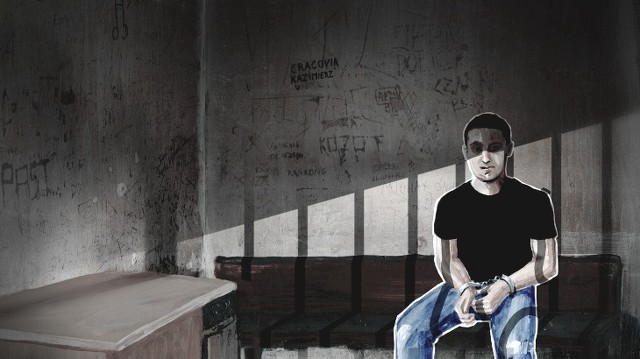
A meaningless death, in animation
Claudio Crulic was a Romanian in his early thirties who was jailed twice in Poland for thefts he apparently did not commit, and the second time he went on a hunger strike that led to his death months later. Despite letters and appeals to the Romanian consul and government and repeated medical examinations, Crulic was ignored by everyone and allowed to deteriorate to a point of no return. It was a scandal that the authorities didn't prevent him from dying in this way, and a minster resigned. The purpose of this 73-minute animated feature is to tell this strange, sad story. The hand-drawn look and the collaged photos plus voice-over first-person narration from beyond the grave by the actor Vlad Ivanov (of 4 Months, 3 Weeks, 2 Days and Pollice, Adjective) contribute to a poetic, Kafkaesque quality. One is charmed (and horrified). and one can identify. A documentary would not have the same effect -- you'd not get the dark humor.
As the voice tells Crulic's tale he seems doomed. For example he says his whole life can be told in a hundred photos. We see the photos, from baby through adolescent raised by female relatives to young adult who quits school early to provide family support, ending with a couple of seaside shots in Italy with his sister. This viewpoint seems reductive. He lists, for example, all the objects that were with him when he died. Before that he lists the objects people bought from outside in Romania. He made a living by purchasing things in Poland and bringing them back to sell. This seems to have something to do with his being considered a thief. The materiality of the account underlines the Kafkaesque absurdity of the life.
After the handling of the body after death and the span of the life have been told, English narration by Jamie Sives, describes the effect of his fast, step by grim step, and the bureaucratic ignoring of his ordeal. The interjection of English as well as the heavy Scottish accent of Siven create a somewhat jarring effect. Animation shows Crulic's last days and death. By the time doctors finally acknowledged the danger his body was in and sought permission to intervene it was too late. A needle punctured his lung, which was already damaged by pneumonia. A long sequence shows his shroud floating away, as if it were his soul. At the end there are some clips from TV about the story covered in the news, the scandal, and the resignation of the government minister.
One might contrast this with the more realistic and physically enacted story of a hunger strike to the death in Steve McQueen's Hunger, in which Michael Fassbender plays the Irish political prisoner Bobby Sands. That was one nation repressing another's independence struggle. This is merely bureaucracy crushing a low income foreign national protesting his false imprisonment. The tragedy of an ordinary man.
Damian deserves credit for treating her subject in a distinctive and artistic way. Hopefully this is a fairly unique incident, but the way a powerless man can be chewed up and spit out by the modern bureaucratic machine is hardly unusual.
Crulic: The Path to Beyond/Crulic - drumul spre dincolo debuted at Locarno and has shown at several other festivals. It was screened for the press for New Directors/New Films (MoMA and the Film Society of Lincoln Center, March 21-April 1, 2012) and is scheduled for public viewings:
Friday, March 23rd | 6:30 PM | MoMA
Saturday, March 24th | 2:00 PM | FSLC
Last edited by Chris Knipp; 07-23-2014 at 07:21 PM.
-
Sacha Polak: Hemel (2012)--ND/NF
SACHA POLAK: HEMEL (2012)--ND/NF

HANNAH HOEKSTRA IN HEMAL
Dutch girl finding herself, mainly through sex
She is young, she is beautiful (but too thin), she is rich (or her father is), she's annoying, and she's sex-crazed, and did I mention she's annoying? This is Hemel (Hannah Hoekstra), a Dutch girl, and her name means Heaven. She is close to her father Gijs (Hans Dagelet), who's in the art auctioning business, apparently, and maybe Hemel's promiscuity competes with her father's, because he has had a series of affairs all Hemel's life, sometimes with women not much older than she is now. Her mother died shortly after she was born. This is an accomplished film, a beautiful film, and a film that should put its Dutch director Sacha Polak on the international sexy art film map. Hemel seems sex-obsessed and scenes show plenty of frontal nudity and other body-realism, including her peeing standing up, something you may not have seen in a non-porn film up to now. But this isn't a female Shame, though at first it might seem so. Hemel is also looking for a grown up man (another, better father?), and this film unlike McQueen's, at least passingly alludes to a network of complex familial relationships. There is something short of depth here, partly through the limitations of the (annoying, did I say?) protagonist's point of view, partly through the stylish but narratively stunting organization of the film into eight disparate titled segments.
Polak's method, especially initially (she gains greater credibility as time goes on) is too easy and too obvious. She opens with two very white naked bodies lying in plain daylight. This is her first of a series of pickups, the white man (Ward Weemhoff) who shaves Hemel's pubic hair (with the stand-up peeing scene as a bonus). This is not, as in a certain Romanian film, a sequence of effective character development or interesting conversation, though Hemel is annoying, right away. What is developed is the sense that the film is trying hard to seem bold about sex and to show that its protagonist is experimenting in that area. A little obvious variety: she picks up, screws, and dumps an Arab man (Abdullah El Baoudi), who is annoying in his own right (he declares Algerian men, of which he is one, to be the worlds' best lovers), and to whom she behaves in a crudely racist manner, and then kicks him out of bed when he wants to make out after sex. Next comes an S&M guy, who chokes her and knocks her around a bit. And that about does it except for a sexy Flamenco singer in Spain, but she only gets to dance with him. (Contractual obligations, since this is a Netherlands-Spain co-production?)
After the establishment of the sexual obsession, what follows is the "Father and Daughter" segment, which establishes that Hemel and her dad have a solid relationship, if one that is too like a platonic marriage. When Gijs introduces Sophie (Rifka Lodeizen), a Christie's colleague he seems really serious with, Hemel shows jealousy and discomfort. It is at this point if not long before that it becomes clear that, as Variety put's it, "Helena van der Meulen's screenplay is a tad too schematic." More than a tad. Variety is right that the scene when Hemel barges in on a brithday party for her "ex-stepbrother" Teun (Maarten Heijermans), a devout Protestant with a fiancee who's a virgin, they having pleged not to have premarital sex, this adds an interesting, unexpected note and is "well-observed." But Heijermans somehow seems a "tad" too pretty for his character, the whole film leaning too much toward the visual -- helped, naturally, by the beautiful camerawork by Daniel Bouquet.
The next key piece in the not-so-puzzling puzzle is the scene in which Hemel is first in bed with and then walking on the beach with a more grown up, nicer, bearded, married, tight-lipped lover (Mark Rietman) whom she wants to "get inside" and "know about," etc. In other words, she has found a guy who might be of interest outside of bed. Much of the film is about Hemel's close relationship with her father, whose girlfriends she is sometimes close to and sometimes jealous of. Due to the sex obsession and the closeness, for a bit we may be forgiven for expecting an incest scene. Instead, coming in out of a chilly rain, there's "only tea," with an older woman, perhaps an earlier lover of her fathers' -- this relationship is confused -- who seems to have known Hemel when she was very young.
Hoekstra does remarkably for a recent acting school graduate who's never been in a film, just as Polak does well for a director who's never made a feature. This could be straight to video stuff it it were merely sexy and ravishing to look at, but I realize that -- though penetrating analysis of relationships and psychology seem a way off still -- we should cut Polak some slack here. Maybe she and her next protagonist will grow up next time or she will develop more distance between the two. New director, new film: yes; this may be promising. It holds the attention.
Hemel (Netherlands, Spain, 80 min.) debuted at Rotterdam and showed at the Berlinale. It opens in cinemas in the Netherlands March 29, 2012. It was screened for this review as part of the Museum of Modern Art-Film Society of Lincoln Center New York series, New Directors/New Films, where it will show at these times and places:
Friday, March 23rd | 9 PM | FSLC
Sunday, March 25th | 5 PM | MoMA
Last edited by Chris Knipp; 07-23-2014 at 07:23 PM.
-
Pierre Schöller: The Minister (2011)--ND/NF
PIERRE SCHÖLLER: THE MINISTER (2011)--ND/NF
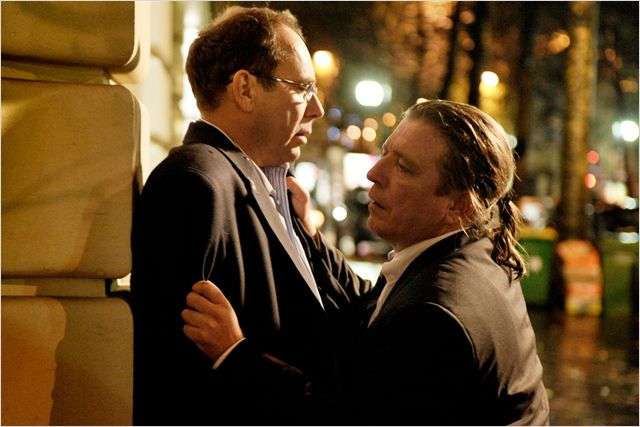
OLIVIER GOURMET AND SYLVAIN DEBLÉ IN THE MINISTER
Previously reviewed in Paris, Oct. 27, 2011.
The inside/outside of politics and government
The Minister is a fabulously exciting and smart French film about politics, though its politics are so deeply French that aspect of the film may partly be inaccessible to American viewers, despite the otherwise rich human content, the outsider-newcomer role the minister plays and the stresses and shocks he endures. It's obvious for the French to compare it to The Conquest, the rich and well-produced, but conventional, biopic about Sarkozy's rise to power that came out earlier in the same year in France. And it emerges at once that The Minister is the more probing and original film. The Conquest is only about externals. The Minister is by design about both how government works internally, its inner workings, how decisions are really made and carried out -- on the one hand -- and -- on the other hand -- from the protagonist's point of view, how it feels to be new in a high position of government (ministerial level). The latter, in France, I'm feeling, is more visible and sensitive responsibility than in the US, because a government minister is out there in the public eye nowadays than their American counterparts currently are. But besides The Conquest the French also compared The Minister to The Ides of March with Clooney and Gosling, because it came out in Paris in the same week. The Ides of March is a good but not great political thriller whose focus on an election limits its scope to a miniature version of what The Conquest is about. It's superficial. And its stars are in all ways more flashy, and have less depth in these roles than Olivier Gourmet and Michel Blanc. The French critics liked The Ides of March better than the merely workmanlike and unoriginal The Conquest, but they saved their raves for The Minister.
The French title of The Miister is more expressive of the director Pierre Schöller's purpose in making his film. It's L'Exercice de l'État, literally "the exercise of the state," which alludes to carrying out the actual inner workings of national government -- how and by whom decisions get made and carried out. This is why in the film the ministry PPS (principal private secretary) Gilles, played by Michel Blanc, is just as important a character as the Bertrand Saint-Jean, the Transport Minister played by Olivier Gourmet. Both are powerful and selfless actors, Olivier Gourmet of an energy and conviction that are unmatched, Blanc projecting competence, integrity and class. Because politics is conducted by insiders and political aristocrats, it's important that Gilles (Blanc) is a political aristocrat and insider. When, in a totally insiders' decision, Woessner (Didier Bezace), another old-timer and insider, is chosen to figurehead as a PPS the new project to privatize the railway stations, it's Gilles, an old friend of Woessner, who has him over in the evening for a meal of eggas and bacon that he cooks himself and serves with a bottle of the best white burgundy.
But the film isn't just an affairs of state story. It centers on the issue of privitization of stations, but it begins with a terrible bus accident up in the mountains. This shows how tense and demanding the Minister's work is. It also shows how media and image are as important as action. It is obvious though the minister must face the dead children and the grieving parents, it's his public statements and who picks them up and where and how they spin hem that count most on this evening. Before that, in the first image of the film, comes the naked lady who crawls inside the crocodile's mouth, the nightmare of the minister, which shows the way his work pursues him even in his dreams.
But most of all the film is given a unique shape by the theme of the unpreditable in another strain. This comes into play through the "chaumeur inconnu," the "unknown unemployed man," Martin Kuypers (played by an unknown non-actor, Sylvain Deblé). He is the guy hired for a month so the minister's regular driver can go on leave to be with his newborn baby. Perhaps because he needs to connect with somebody -- his phone list has flashed on the screen and he's said he has 1500 contacts but no friend -- Satint-Jean bonds with Kuypers, going to his trailer home and getting drunk with him and his outspoken wife Pauline (Zabou Breitman).
A while later there comes the shocking accident where Kuypers crashes the official car and it turns over multiple times with a horrifying sound, with Saint-Jean's publicity secretary with him, and Kuypers is thrown from the car and dies, and Saint-Jean is with him when his soul leaves his body. The event changes Saint-Jean forever. His survival is a miracle, and strengthens him with the public. Even this is a matter of public relations, because a speech is written about Kuypers, and then Pauline requests a low profile, and the speech must be jettisoned. When Saint-Jean speaks the speech to himself in a whispier at the memorial serivce were the whole main government is present, it underlines the minister's personal, private relationship with this faceless man. It's a brilliant scene underlining the inner and outer aspects of the narrative.
Pierre Schöller isn't a new director but this film is so different from his last one, the 2008 Versailles, that he seems reborn with this long-gestating fim. The Minister debuted at Cannes May 19, 2011, and opened in Paris October 26, 2011 and I reviewed it then (see link above). It was screened for thIs new review as part of the 2012 Museum of Modern Art-Film Society of Lincoln Center series New Directors/New Films series, when it will be shown to the public at the following times and venues:
Friday, March 23rd | 9 PM | MoMA
Sunday, March 25th | 1:30 PM | FSLC
©Chris Knipp 2012
Last edited by Chris Knipp; 03-09-2012 at 08:12 PM.
 Posting Permissions
Posting Permissions
- You may not post new threads
- You may not post replies
- You may not post attachments
- You may not edit your posts
-
Forum Rules





 Reply With Quote
Reply With Quote

















Bookmarks